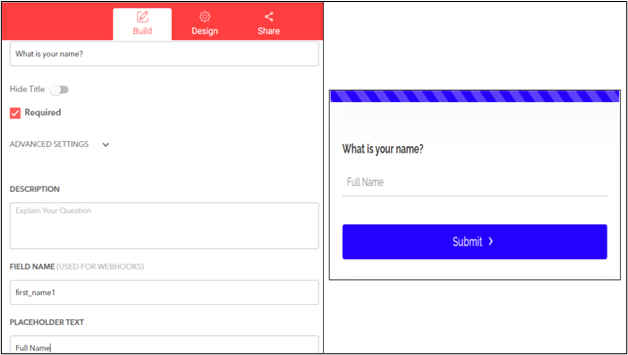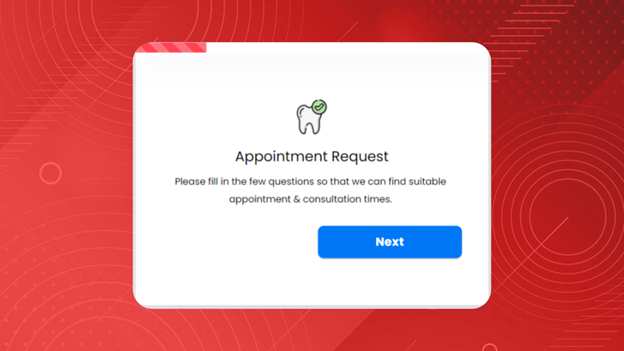Appointment Forms: Take Bookings and Appointments Online
Introduction
Managing appointments as a company owner may be a difficult endeavor, especially if you do it the old-fashioned way–by email or phone. Does this sound familiar? The first step in resolving any problem is recognizing that one exists. And you're already on the right track if you're seeking a more efficient approach to managing appointment requests.
Say goodbye to paper forms and welcome hassle-free online appointment forms.
Most clients nowadays will hunt for a service provider online, and the easiest way to submit and accept reservations is via an online appointment form. A smart place to start is with an appointment form template. A form builder will frequently allow you to add fields, tailor data capture, change the look, and add branding.
What are Online Appointment Forms?
Online appointment forms, also known as booking forms or scheduling forms, are digital tools used to facilitate the process of scheduling appointments or meetings with clients, customers, or individuals. These forms are typically integrated into a website or accessible through a web link, allowing individuals to request appointments or book specific time slots based on their availability and preferences.
The main purpose of online appointment forms is to streamline the appointment booking process, replacing traditional methods, such as phone calls or emails.
These forms often include various fields and features to gather essential information from the requester, such as their name, contact details, desired date and time for the appointment, and any specific requirements or reasons for the appointment. The key features and benefits of online appointment forms include:
1. Convenience: Online appointment forms provide a convenient and user-friendly way for individuals to request appointments at their own convenience without the need for direct communication or time-consuming back-and-forth exchanges.
2. Time savings: By automating the appointment booking process, online forms save time for both the requester and the service provider. They eliminate the need for manual scheduling, reducing administrative tasks and potential errors.
3. 24/7 availability: Online appointment forms are accessible around the clock, allowing individuals to submit appointment requests at any time, even outside of regular business hours.
4. Real-time availability: Many online appointment forms integrate with scheduling software or calendars, displaying real-time availability for specific time slots or services. This enables requesters to see open time slots and select the most suitable option.
5. Customization: Online appointment forms can be customized to fit the specific needs of different industries and businesses. They can include additional fields for collecting specific information, offer multiple service options, or incorporate payment processing for services requiring upfront payment or deposits.
6. Automated confirmations and reminders: Upon submitting an appointment request, online forms can automatically send confirmation emails or text messages to both the requester and the service provider. Reminders can also be set to ensure both parties are prepared for the appointment.
Online appointment forms benefit a wide range of businesses and professionals that rely on scheduling appointments, such as healthcare providers, beauty salons, consultants, therapists, tutors, and many others.
These forms streamline the booking process, enhance customer experience, reduce scheduling conflicts, and improve overall efficiency in managing appointments.
Tips & Tricks on Building an Effective Appointment Form
A clumsy, inefficient form might cost you a lead. Yes, you read that correctly. You may lose a potential customer if they do not comprehend or fill out the form correctly. As a result, in the following sections, we'll go over design strategies to make your appointment form more user-friendly.
1. Fields that are simple to fill out should be placed first
Put the fields that require the least amount of time to fill out at the top of the form. Leave the heavy-text comment areas to the conclusion of the submission, if possible. If a form begins with enormous text fields, it may deter prospects from filling it out or cause them to postpone submission. Meanwhile, if they begin with checkboxes and other simple forms, they are more likely to complete the submission halfway through.
2. Save your clients' time by using checkboxes and dropdown menus
If you want to classify or pre-fill certain replies, use dropdown lists, checkboxes, or radio buttons. It not only saves your prospects time and work, but it also makes appointment requests easier to arrange and scan. It should be noted that all fields in LeadGen App are created as necessary by default. To make a field optional, click on it to expand the options and uncheck the 'Required' checkbox.
3. Create distinct form types for each page
Should your appointment request form be eye-catching? That is a difficult question. On the one hand, you obviously want people to schedule appointments. However, you don't want to be overly aggressive about showing the form when your website visitors aren't ready to fill it out.
In such a situation, you may create two sorts of forms. A pop-up may show on a page where visitors are likely to be interested in arranging an appointment. These might include the Contact, Pricing, and Schedule pages. You can add a less invasive panel that expands when you click on the remaining pages.
4. To reduce doubt, include microcopy
The ideal approach is to keep field labels as brief as possible. However, if you believe your prospects would be confused about the function of certain areas, you might include a microcopy–a little piece of text created for explanatory purposes. Here's an example of a clear microcopy:
Another excellent application of microcopy is reducing impediments and worries from clients. As an example, consider the safety problem. Sharing personal information online is a delicate matter, thus including your Privacy Policy in the microcopy will show the website's credibility. You can provide a copy of your Privacy Policy at the bottom of your form.
What is an Appointment Request Form?
Potential consumers can request an appointment with you using online appointment forms. Many of these appointment forms connect to your calendar, preventing repeated bookings. Furthermore, these forms allow you to collect essential information about your clients.
These forms are clearly highly beneficial for service company experts. They integrate the functionality of booking forms and contact forms into a single application.
The program will add appointments to your calendar depending on the type of booking tool you are using. You may also manually add them, allowing you to choose which clients you want to work with and which ones you don't.
Important Appointment Request Form Information Fields
Each appointment request form should include the following information:
a. Information about how to contact us: You should at the very least obtain the person's name and email address. You may develop a list of potential clients using the email addresses. You can also request their phone number and address, depending on your field of business.
b. Availability: A booking form is not the same as an appointment request form. Filling out and submitting a request does not guarantee a specific time period. Who decides whether to schedule someone?
c. The reason for making an appointment: Every customer is unique, so it's important to understand why they want to meet with you in the first place. This assists you in preparing for a meeting and providing the best possible service. It is entirely up to you whether to include any more fields that you believe are necessary.
How Can You Use the Appointment Request Form?
The booking procedure grows more difficult as the number of appointments increases. Using simply the phone and email might result in multiple appointments, no-shows, and confusion. Many of these issues may be solved with an appointment request form. It relieves a lot of tension while still allowing everyone to keep their appointments.
An appointment request form collects information relevant to the appointment. The most fundamental information is as follows:
a. Contact details
b. Reason for requesting the appointment
c. Name of the person making the booking request
Once you have these facts, you will be able to provide your prospective consumers with exactly what they desire. Forms for appointment requests are used in a variety of sectors, including:
a. Getting new leads
b. Requesting consultation meetings
c. Scheduling doctor’s appointments
d. Scheduling lessons
Benefits of Having an Appointment Form on Your Website
It's usual for medical clinics to include an appointment scheduling service or an appointment request form on their website these days. However, there are still numerous practices that are opposed to the notion. There are several logical reasons why a clinic may not wish to enable online appointment scheduling or requests. Perhaps none of the online scheduling solutions offered interact effectively with the practice's current appointment scheduling system.
In other circumstances, these online requests may not fit into the practice's present process, or there may be a fear that they may go through the gaps if front desk personnel are already overburdened.
Having said that, there may be advantages to providing online choices for people who wish to arrange an appointment. It may be worthwhile to assess your present processes to determine whether online appointment requests may be made to work for your firm.
Some of the reasons your clinic should consider having an online appointment request form are as follows:
a. Online Forms help you get patients after-hours
If a patient can only reach your office after hours, an appointment request form or online scheduling tool may be preferable to phoning. Most individuals will not call, leave a message, and wait for someone to call them back if given the opportunity. They are far more likely to switch to a clinic that permits them to schedule an appointment immediately away.
b. Patients have come to expect online options
We now live in a time when we can order whatever we desire, from restaurant meals and groceries to apparel, pharmaceuticals, and even transportation, without ever picking up the phone. People naturally expect to be able to do the same for their medical visits.
While many patients are perfectly comfortable picking up the phone and calling your office, some will refuse or do not have the time to do so. You could be passing up those patients. This is especially true if you treat a lot of younger patients who are used to purchasing things online.
c. Your competitors already have an appointment form
The great majority of your rivals will have at least one (and most likely more) appointment request form. If a patient is unable or unwilling to pick up the phone, there is a strong risk that they will choose your competition instead.
Create your Appointment Form for your website with LeadGen App Today and stay ahead of your competitors!
It is now more crucial than ever to remove any and all potential barriers to getting patients to contact you. Elective operations have been reduced compared to prior years since COVID-19 swept the United States, and that trend is expected to continue. Because the surgical market is less than it once was, it is even more vital that you remove any barriers to patient acquisition if you want to maintain current volumes.
d. Appointment forms might really reduce the workload on your personnel
One typical objection to appointment forms is that "we don't have the time or staff to handle online appointment requests." Perhaps it is true of your practice's present process, but modifying it to accept online inquiries could reduce some of the load.
If your phone is continually ringing, you're undoubtedly putting people on hold most of the time, and it may be impossible for your front desk personnel to get much else done while answering phones.This is a difficult workflow for everyone concerned.
By allowing patients to make their requests online, an online appointment request or scheduling form can assist in minimizing the number of phone calls.
Changing your process to incorporate online forms may be quite beneficial, especially if your office is understaffed and unable to handle all phone calls. One practice we partner with actually changed their automated hold message to inform people that they may request an appointment through the Internet.
This is a terrific approach to let patients know that they have the option if they can't or don't want to wait on hold, and it helps to minimize the number of patients waiting for your staff to respond. You may assign one person to handle online requests, or you can have the entire staff pitch in based on who has time. Yes, it will necessitate a change in your present workflow and may necessitate some trial and error, but if you figure it out, it may be a valuable adjustment.
Benefits of Using an Online Appointment System
What exactly is a web-based appointment system? In a nutshell, it's software that lets clients arrange appointments through your website. The work is then instantly added to your calendar.
On the surface, it appears easy, but the advantages of an online appointment system are numerous! A simple scheduling procedure leads to more work bookings. Workflow organization, more productive workdays, and happier customers help teams like yours.
With an effective scheduling mechanism in place, your office personnel can focus on more vital activities, and your field crew can get more done each day.
If you're still not convinced, consider the following significant advantages of an online appointment system:
1. New Appointments go directly into your diary
The finest online appointment systems link to your calendar immediately. When appointments are automatically booked, you may drastically reduce the amount of time you spend on boring scheduling duties.
You won't have to worry about manually booking new tasks using automation. Your office may concentrate on other aspects of your business!
Leave voicemails, phone tag games, and disorganized calendars in the past! Online booking can help your team obtain an appointment more quickly, complete the task more quickly, and ultimately be paid more quickly.
2. Online appointment systems easily convert new prospects
More leads are converted when a booking system is simple and easy to use. Consider your online booking site to be a 24/7 lead generation factory! Online appointment systems help businesses develop by making it simple for new clients to fill out a form and enter their information into your CRM. This makes it much easier to acquire new consumers and enter their information without involving the administration.
On top of that, you have a new job booked in minutes!
3. An online appointment system is quick and easy for customers
Remember that your online appointment system should be adaptable and adaptable. You should have the ability to control which services your consumers can and cannot book online. It is entirely up to you; just the services you choose to list will be displayed on your online booking form. Customization is beneficial to both your organization and your clients.
A well-designed booking form menu not only looks professional but also helps consumers swiftly select the service they want. Even better, you may add the service fee so clients are informed of what they will be charged.
4. Reduce admin time spent on appointment jobs
Simply said, online booking systems are easier to administer than traditional methods. An online appointment system relieves a lot of strain on your office staff. This can increase the efficiency of your whole organization by allowing your employees to dedicate more time to higher-priority duties.
Furthermore, this technique reduces scheduling problems and misunderstandings. Customers enter their information immediately into the form, eliminating the need to listen carefully to details over the phone and accurately record them.
Most Popular Appointment Form Templates
Some of the most popular appointment form templates are as follows:
a. Appointment of Representative Form
The Appointment of Representative Form is a document used in various legal, medical, and administrative settings to designate someone as an authorized representative to act on behalf of another individual or entity. The purpose of this form is to grant legal authority to the appointed representative to make decisions, communicate, or handle specific matters on behalf of the appointing party.
The Appointment of Representative Form typically includes the following information:
1. Appointing party: The form will require the personal details of the individual or entity appointing the representative. This includes their name, contact information, and any relevant identification or account numbers.
2. Representative information: The form will collect the details of the appointed representative, including their name, contact information, and any necessary identification or credentials.
3. Scope of representation: The form will specify the purpose and scope of the representative's authority. This may include areas such as legal matters, healthcare decisions, financial transactions, or administrative procedures.
4. Duration of appointment: The form may include provisions for specifying the duration of the representative's authority. This can be a specific time period or an ongoing appointment until revoked.
5. Signatures: The appointing party and the representative will need to sign and date the form to make the appointment legally binding. The Appointment of Representative Form is commonly used in various contexts, including:
a. Legal representation: In legal proceedings, such as court cases or administrative hearings, individuals may appoint an attorney or legal representative to act on their behalf and make decisions related to their case.
b. Healthcare representation: Patients may use this form to designate someone, such as a family member or close friend, as their healthcare proxy or medical power of attorney. This allows the representative to make healthcare decisions if the patient becomes incapacitated or unable to communicate their preferences.
c. Government agencies: Government entities may require individuals or organizations to appoint representatives to handle administrative matters, such as tax filings, benefits claims, or interactions with government agencies.
d. Financial matters: Individuals or businesses may appoint representatives to handle financial transactions, manage accounts, or make financial decisions on their behalf.
The Appointment of Representative Form provides legal clarity and establishes the authority of the designated representative. It ensures that the representative has the necessary legal standing to act on behalf of the appointing party and facilitates smooth communication and decision-making processes in various contexts.
Appointment of Agent Form
The Appointment of Agent Form, also known as the Power of Attorney form or Agency Appointment Form, is a legal document used to appoint an individual or entity as an agent or representative to act on behalf of another person or organization. This form grants legal authority to the appointed agent to perform specific tasks or make decisions on behalf of the appointing party.
The Appointment of Agent Form typically includes the following elements:
1. Appointing party: The form requires the personal details of the individual or organization appointing the agent. This includes their name, contact information, and any necessary identification or account numbers.
2. Agent information: The form collects the details of the appointed agent, including their name, contact information, and any relevant identification or credentials.
3. Powers and limitations: The form specifies the scope of the agent's authority. It outlines the specific tasks, actions, or decisions the agent is authorized to perform on behalf of the appointing party. The form may also include any limitations or restrictions on the agent's authority.
4. Duration of appointment: The form may include provisions for specifying the duration of the agent's authority. This can be a specific time period, an ongoing appointment until revoked, or contingent upon certain events.
5. Signatures: Both the appointing party and the agent will need to sign and date the form to make the appointment legally binding.
The Appointment of Agent Form is commonly used in various scenarios, including:
1. Financial matters: Individuals or organizations may appoint agents to manage their financial affairs, such as banking transactions, investments, or property management.
2. Real estate transactions: In real estate, individuals may appoint agents to represent them in buying, selling, or leasing properties.
3. Legal representation: Individuals may appoint attorneys or legal professionals as agents to handle legal matters and make decisions on their behalf.
4. Business transactions: Business owners may appoint agents to act on their behalf in negotiations, contracts, or other business-related activities.
5. Healthcare decisions: Individuals may use this form to appoint healthcare agents or establish a healthcare power of attorney, granting someone the authority to make medical decisions if they become incapacitated or unable to communicate their wishes.
The Appointment of Agent Form is crucial for establishing a legal relationship of the agency, ensuring that the appointed agent has the necessary authority to act on behalf of the appointing party. It provides clarity, legal protection, and a framework for the agent to carry out their duties and responsibilities in various legal and business contexts.
Appointment of Scheduling Form
The term "Appointment of Scheduling Form" is not a commonly used or recognized term in standard business or legal contexts. It may be a specific form or document created by an organization or entity for its own internal scheduling purposes. Without further context or information, it is challenging to provide a definitive answer.
However, based on the given term, it is possible that an "Appointment of Scheduling Form" refers to a form or document used to schedule appointments or allocate time slots for specific purposes. This type of form typically includes the following elements:
1. Appointment details: The form would include fields to specify the purpose of the appointment, such as a meeting, consultation, service, or event.
2. Date and time: The form would provide options or spaces for the requester to indicate their preferred date and time for the appointment or to select from available time slots.
3. Contact information: The form would collect the requester's name, contact details, and any additional relevant information necessary to confirm and communicate about the appointment.
4. Confirmation and reminders: The form may include options for confirming the appointment and requesting reminders through email, SMS, or other means.
5. Additional requirements: Depending on the nature of the appointment, the form may have fields to gather specific requirements or information needed for the appointment to be successfully scheduled.
The benefits of using an Appointment of Scheduling Form include streamlining the scheduling process, reducing scheduling conflicts, improving efficiency, and enhancing the overall customer or client experience.
It's important to note that the specific design and content of an "Appointment of Scheduling Form" can vary depending on the organization or entity creating it. Therefore, it would be best to seek further clarification or refer to the specific form or document provided by the relevant entity to fully understand its purpose and functionality.
Doctor Appointment Form
A Doctor Appointment Form, also known as a Medical Appointment Form or Patient Appointment Form, is a document used by medical facilities, clinics, or healthcare providers to collect necessary information and schedule appointments with patients. The form serves as a communication tool between patients and healthcare providers, ensuring efficient and organized appointment scheduling.
A typical Doctor Appointment Form includes the following components:
1. Patient information: The form collects the patient's personal details such as name, contact information, date of birth, and address. This information helps identify the patient and maintain their medical records.
2. Appointment details: The form includes fields to specify the purpose of the appointment, preferred appointment date and time, and any additional notes or requests regarding the appointment.
3. Medical history and symptoms: The form may include sections to record the patient's medical history, current symptoms, or any specific concerns they wish to discuss during the appointment. This information helps healthcare providers understand the patient's medical background and prepare for the visit.
4. Insurance and payment information: The form may request details about the patient's insurance coverage, policy number, and billing information. This ensures that necessary financial arrangements can be made for the appointment.
5. Consent and authorization: Depending on the medical facility's policies and procedures, the form may include sections for the patient to provide consent for treatment, acknowledge privacy practices, and authorize the release of medical records if needed.
The benefits of using a Doctor's Appointment Form include the:
1. Streamlined scheduling: The form helps medical facilities organize and manage appointments effectively, avoiding scheduling conflicts and ensuring the availability of healthcare providers.
2. Patient information collection: The form enables the collection of important patient details, medical history, and symptoms, allowing healthcare providers to prepare adequately and provide appropriate care.
3. Improved communication: The form serves as a communication tool, ensuring that patients can clearly communicate their appointment preferences, concerns, and medical history to healthcare providers.
4. Enhanced efficiency: By collecting necessary information in advance, the form helps streamline the check-in process, reducing waiting times and improving overall efficiency in healthcare facilities.
Overall, Doctor Appointment Forms facilitate the smooth and organized scheduling of appointments, enhance communication between patients and healthcare providers, and contribute to efficient healthcare delivery.
Trustee Appointment Form
A Trustee Appointment Form is a legal document used to appoint or designate an individual or entity as a trustee of a trust. A trust is a legal arrangement where a person (known as the settlor or grantor) transfers their assets to a trustee who holds and manages those assets for the benefit of the trust's beneficiaries.
The Trustee Appointment Form typically includes the following elements:
1. Settlor information: The form collects the personal details of the settlor or grantor who is creating the trust. This includes their name, contact information, and any necessary identification or account numbers.
2. Trust details: The form includes information about the trust, such as the trust's name, date of creation, and any specific provisions or instructions outlined in the trust document.
3. Trustee information: The form gathers the details of the individual or entity being appointed as the trustee. This includes their name, contact information, and any relevant identification or credentials.
4. Powers and responsibilities: The form outlines the powers, duties, and responsibilities of the trustee. This may include managing and investing trust assets, distributing income or principal to beneficiaries, making decisions regarding the trust, and adhering to applicable laws and regulations.
5. Effective date and signatures: Both the settlor or grantor and the appointed trustee will need to sign and date the form to make the appointment legally binding.
The Trustee Appointment Form is a critical document in the administration of a trust. It establishes the legal relationship between the settlor and the trustee and defines the trustee's role and authority within the trust structure. It ensures that the trust assets are managed and administered according to the settlor's wishes and for the benefit of the trust beneficiaries.
The Trustee Appointment Form benefits the settlor, as it allows them to choose a trusted individual or entity to oversee the management of their assets and ensure the proper administration of the trust. It also benefits the trustee, as it grants them legal authority and outlines their responsibilities in fulfilling their fiduciary duties.
It's important to note that the specific design and content of a Trustee Appointment Form can vary depending on jurisdiction and the particular requirements of the trust. Seeking legal advice or utilizing standardized legal forms specific to your jurisdiction is recommended when creating or utilizing such a form.
Dentist Appointment Form
A Dentist Appointment Form, also known as a Dental Appointment Form or Patient Appointment Form, is a document used by dental clinics or dentists' offices to schedule and manage appointments with patients. The form serves as a means of communication between the dental provider and the patient, ensuring efficient appointment scheduling and effective dental care.
A typical Dentist Appointment Form includes the following components:
1. Patient information: The form collects essential patient details such as name, contact information, date of birth, and address. This information helps identify the patient and maintain their dental records.
2. Appointment details: The form includes fields to specify the purpose of the appointment, preferred appointment date and time, and any additional notes or requests regarding the appointment. Patients can indicate the reason for their visit, such as a regular check-up, dental cleaning, specific dental treatment, or consultation.
3. Medical and dental history: The form may include sections to record the patient's medical and dental history, including previous dental treatments, allergies, medications, and any specific dental concerns they wish to discuss during the appointment. This information helps dentists assess the patient's dental health and provide appropriate care.
4. Insurance and payment information: The form may request details about the patient's dental insurance coverage, policy number, and billing information. This ensures that necessary financial arrangements can be made for the appointment and subsequent treatments.
5. Consent and authorization: Depending on the dental practice's policies and procedures, the form may include sections for the patient to provide consent for dental treatment, acknowledge privacy practices, and authorize the release of dental records if needed.
The benefits of using a Dentist Appointment Form include:
1. Efficient scheduling: The form helps dental clinics manage their appointment schedule, reducing scheduling conflicts and ensuring the availability of dental professionals.
2. Patient information collection: The form allows dental providers to collect important patient details, medical and dental history, and specific concerns, enabling them to deliver personalized and effective dental care.
3. Enhanced communication: The form serves as a communication tool, ensuring that patients can clearly communicate their appointment preferences, dental concerns, and medical history to dental providers.
4. Streamlined administrative processes: By collecting necessary information in advance, the form helps streamline the check-in process, saving time for both the patient and the dental clinic.
Overall, Dentist Appointment Forms facilitate the smooth and organized scheduling of dental appointments, improve communication between patients and dental providers, and contribute to efficient dental care delivery.
Medical Appointment Form
A Medical Appointment Form, also known as a Patient Appointment Form or Healthcare Appointment Form, is a document used by medical clinics, hospitals, or healthcare providers to schedule and manage appointments with patients. The form serves as a means of communication between the healthcare provider and the patient, facilitating efficient appointment scheduling and ensuring the delivery of appropriate medical care.
A typical Medical Appointment Form includes the following elements:
1. Patient information: The form collects essential patient details such as name, contact information, date of birth, and address. This information helps identify the patient and maintain their medical records.
2. Appointment details: The form includes fields to specify the purpose of the appointment, preferred appointment date and time, and any additional notes or requests regarding the appointment. Patients can indicate the reason for their visit, whether it's a routine check-up, follow-up consultation, specific medical condition, or preventive screening.
3. Medical history: The form may include sections to record the patient's medical history, including past and current medical conditions, allergies, medications, surgeries, and any specific medical concerns they wish to discuss during the appointment. This information helps healthcare providers assess the patient's health and provide appropriate care.
4. Insurance and payment information: The form may request details about the patient's health insurance coverage, policy number, and billing information. This ensures that necessary financial arrangements can be made for the appointment and any subsequent medical treatments.
5. Consent and authorization: Depending on the healthcare provider's policies and procedures, the form may include sections for the patient to provide consent for medical treatment, acknowledge privacy practices, and authorize the release of medical records if needed.
The benefits of using a Medical Appointment Form include:
1. Efficient scheduling: The form helps healthcare providers manage their appointment schedule, reducing scheduling conflicts and ensuring the availability of medical professionals.
2. Patient information collection: The form allows healthcare providers to gather important patient details, medical history, and specific concerns, enabling them to deliver personalized and effective medical care.
2.Enhanced communication: The form serves as a communication tool, ensuring that patients can clearly communicate their appointment preferences, medical concerns, and medical history to healthcare providers.
3. Streamlined administrative processes: By collecting necessary information in advance, the form helps streamline the check-in process, saving time for both the patient and the healthcare provider.
Overall, Medical Appointment Forms contribute to the smooth and organized scheduling of medical appointments, improve communication between patients and healthcare providers, and facilitate the delivery of quality medical care.
FAQ
Here are some frequently asked questions related to appointment forms:
1. What is an appointment form?
An appointment form is a document or online form used to schedule and organize appointments with individuals or entities. It collects relevant information such as name, contact details, preferred date and time, and reason for the appointment.
2. Why is an appointment form necessary?
An appointment form helps streamline the appointment scheduling process by collecting all the necessary information from the individual or entity seeking an appointment. It ensures that important details are captured accurately, reduces communication errors, and helps the appointment organize prepare for the meeting.
3. What information should be included in an appointment form?
An appointment form typically includes fields for the person's name, contact details (phone number, email, etc.), preferred date and time options, the reason for the appointment, and any additional notes or comments.
4. How do I fill out the appointment of representative form?
To fill out an Appointment of Representative Form, follow these general steps:
a. Obtain the form: Obtain the specific Appointment of Representative Form required by the organization or entity for which you are appointing a representative. This could be a government agency, insurance company, legal institution, or any other entity that requires representation.
b. Read the instructions: Read the instructions provided with the form carefully. These instructions will guide you through the form-filling process and provide information on any supporting documents or additional requirements.
c. Provide your information: Fill in your personal information as the person making the appointment. This includes your full name, contact information, address, and any identification or reference numbers required.
d. Specify the representative: Clearly indicate the full name, contact information, and relationship of the person you are appointing as your representative. This individual will act on your behalf and may need to provide proof of their authority to represent you.
e. Define the scope of representation: Specify the purpose or scope of the representative's authority. This could include legal matters, healthcare decisions, financial transactions, or any other area in which you require representation.
f. Sign and date: Sign and date the form to validate your appointment of the representative. Some forms may require additional witnesses or notarization, so be sure to follow the instructions provided.
g. Attach supporting documents: If required, attach any supporting documents requested by the organization or entity to complete the appointment process. This could include identification documents, power of attorney forms, or any other relevant paperwork.
h. Submit the form: Submit the completed form and any accompanying documents to the appropriate organization or entity as instructed. Follow their preferred method of submission, such as mailing, faxing, or submitting online.
It is important to note that the specific requirements and procedures for filling out an Appointment of Representative Form can vary depending on the organization or entity involved. Therefore, it is crucial to carefully review the provided instructions and seek any necessary guidance or assistance to ensure that the form is completed accurately and in compliance with the relevant requirements.
5. Who benefits from using appointment forms?
Appointment forms benefit both the individuals seeking appointments and the service providers or organizations managing the appointments. Individuals benefit from a clear and organized process for scheduling appointments, while service providers benefit from having all necessary information upfront and being able to manage their schedules efficiently.
6. Can appointment forms be customized?
Yes, appointment forms can be customized to fit the specific needs and requirements of different businesses or organizations. Customization may involve adding or removing fields, including specific instructions or guidelines, or incorporating branding elements.
7. How are appointment forms typically used?
Appointment forms can be used in various industries and sectors, such as healthcare, professional services, education, and more. They are often available online, allowing individuals to conveniently schedule appointments at their preferred time and provide the necessary information in advance.
8. Are appointment forms secure?
It depends on the platform or method used to collect and process appointment form data. It is essential to ensure that appropriate security measures are in place to protect the personal information submitted through the form, such as using secure online form platforms or encryption methods.
9. What happens after submitting an appointment form?
After submitting an appointment form, the service provider or organization typically reviews the information provided and confirms the appointment. They may contact the individual to finalize the details, provide further instructions, or request additional information if necessary.
10. Can appointment forms be integrated with other tools or systems?
Yes, appointment forms can often be integrated with other tools or systems such as calendar applications, customer relationship management (CRM) software, or appointment scheduling software. The integration allows for the seamless transfer of appointment details and better management of the overall scheduling process.
11. Can appointment forms be used for group or team appointments?
Yes, appointment forms can be adapted to handle group or team appointments by including additional fields for multiple participants or by allowing users to indicate the number of attendees. It's important to note that the specific features and functionality of appointment forms may vary depending on the platform or system used, as well as the requirements of the business or organization implementing them.
12. What is the Scope of Appointment Form?
A Scope of Appointment (SOA) form is a document used in the healthcare industry, specifically in relation to Medicare Advantage (MA) and Medicare Prescription Drug Plans (Part D). The form is designed to clarify and document the discussion between an insurance agent or broker and a Medicare beneficiary regarding the products and services offered by the agent or broker.
The purpose of the Scope of Appointment form is to ensure that the agent or broker only discusses and presents information about the specific products and services that the beneficiary has expressed interest in. This helps protect the beneficiary from unwanted or unnecessary solicitations and ensures that they receive information relevant to their needs and preferences.
When completing a Scope of Appointment form, the following information is typically included:
a. Beneficiary's name: The full name of the Medicare beneficiary.
b. Beneficiary's contact information: Contact details such as address, phone number, and email address.
c. Appointment details: The date and time of the scheduled appointment between the beneficiary and the agent or broker.
d. Products and services: The specific Medicare Advantage or Part D plans, as well as any ancillary or supplemental products, that the beneficiary wishes to discuss during the appointment.
By using the Scope of Appointment form, the beneficiary can control the discussion and ensure that the agent or broker provides information related to their specific interests. This form helps prevent unwanted sales pitches and protects the beneficiary from potentially fraudulent or abusive practices.
The Scope of Appointment form benefits both the beneficiary and the agent or broker. The beneficiary benefits by having a clear understanding of the products and services being discussed and by receiving information tailored to their needs. The agent or broker benefits by being able to focus the discussion on the products and services that the beneficiary is interested in, saving time and effort in presenting information that may not be relevant.
It is important for both the beneficiary and the agent or broker to adhere to the information provided on the Scope of Appointment form. The agent or broker should respect the beneficiary's choices and limit their discussion to the specified products and services. Similarly, the beneficiary should feel empowered to ask questions and seek clarification about the products and services being discussed during the appointment.
Conclusion
The majority of consumers now make their appointments online. And they are hoping to be able to do so directly. That is why, in order to avoid wasting your consumers' time, you must design your online appointment system effectively. It would make your job easier if you design a customized online appointment form to capture all of your customer's information during the reservation process. As a result, you won't need to engage someone to keep track of your client's history and current state.
Using an online appointment system is a significant benefit for any field service organization. This application has the potential to help your business development while also keeping clients pleased at any time of day.
Online appointment forms make life easier for both you and your clients. For this, you should use the appropriate form tool. LeadGen App generates a wonderful appointment form that you can quickly and simply add to your website for a fashionable, professional, and personalized appearance. Because it is suited for both mobile and tablet browsers, your clients can book whenever and wherever they choose.
Start building online appointment forms for your website using LeadGen App’s templates!























